Challenges to creating primary care teams in a public sector health centre: A co-operative inquiry
Keywords:
Doctor-nurse relationship, practice teams, teamwork, collaboration, health systems
Abstract
Background Effective teamwork between doctors and clinical nurse practitioners (CNP) is essential to the provision of quality primary care in the South African context. The Worcester Community Health Centre (CHC) is situated in a large town and offers primary care to the rural Breede Valley Sub-District of the Western Cape. The management of the CHC decided to create dedicated practice teams offering continuity of care, family-orientated care, and the integration of acute and chronic patients. The teams depended on effective collaboration between the doctors and the CNPs. Methods A co-operative inquiry group, consisting of two facility managers, an administrator, and medical and nursing staff, met over a period of nine months and completed three cycles of planning, action, observation and reflection. The inquiry focused on the question of how more effective teams of doctors and clinical nurse practitioners offering clinical care can be created within a typical CHC. Results The CHC had established three practice teams, but met with limited success in maintaining the teams over time. The group found that, in order for teams to work, the following are needed: A clear and shared vision and mission amongst the staff. The vision was championed by one or two leaders rather than developed collaboratively by the staff. Continuity of care was supported by the patients and doctors, but the CNPs felt more ambivalent. Family-orientated care within practices met with limited success. Integration of care was hindered by physical infrastructure and the assumptions regarding the care of “chronics. Enhanced practitioner-patient relationships were reported by the two teams that had staff consistently available. Significant changes in the behaviour and roles of staff. Some doctors perceived the nurse as an “assistant who could be called on to run errands or perform tasks. Doctors perceived their own role as that of comprehensively managing patients in a consultation, while the CNPs still regarded themselves as nurses who should rotate to other duties and perform a variety of tasks, thus oscillating between the role of practitioner and nurse. The doctors felt responsible for seeing a certain number of patients in the time they were available, while the CNPs felt responsible for getting all the patients through the CHC. The doctors did not create space for mentoring the CNPs, who were often seen as an intrusion and a threat to patient privacy and confidentiality when requesting a consultation. For the CNPs, however, the advantage of practice teams was considered to be greater accessibility to the doctor for joint consultation. The identification of doctors and CNPs with each other as part of a functioning team did not materialise. Effective management of the change process implied the need to ensure sufficient staff were available to allow all teams to function equally throughout the day, to be cognisant of the limitations of the building design, to introduce budgeting that supported semi-autonomous practice teams and to ensure that the staff were provided with ongoing opportunities for dialogue and communication. The implications of change for the whole system should be considered, and not just that for the doctors and nurses. Conclusions Key lessons learnt included the need to engage with a transformational leadership style, to foster dialogical openness in the planning process and to address differences in understanding of roles and responsibilities between the doctors and the CNPs. The unreliable presence of doctors within the practice team, due to their hospital duties, was a critical factor in the breakdown of the teams.. The CHC plans to further develop practice teams, to learn from the lessons so far and to continue with the co-operative inquiry.
Published
2007-01-22
Section
Original Research
By submitting manuscripts to SAFP, authors of original articles are assigning copyright to the South African Academy of Family Physicians. Copyright of review articles are assigned to the Publisher, Medpharm Publications (Pty) Ltd, unless otherwise specified. Authors may use their own work after publication without written permission, provided they acknowledge the original source. Individuals and academic institutions may freely copy and distribute articles published in SAFP for educational and research purposes without obtaining permission.

